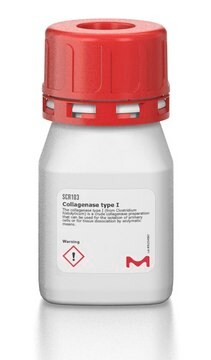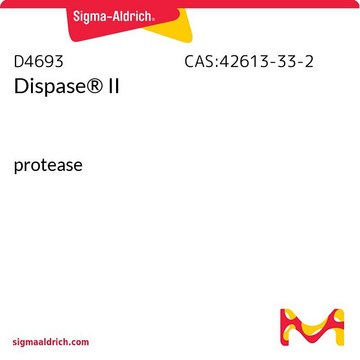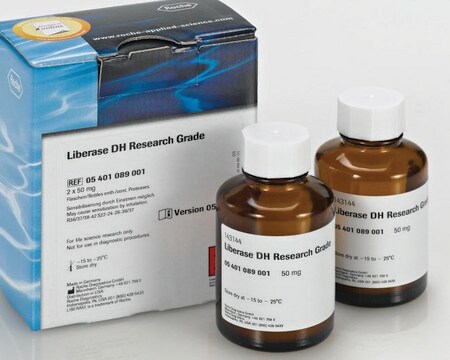COLLDISP-RO
Roche
Collagenase/Dispase®
lyophilized, non-sterile, optimum pH 7.0-8.0
Synonym(s):
collagenase
About This Item
Recommended Products
biological source
enzyme from Bacillus polymyxa ( Dispase )
enzyme from bacterial ( Collagenase from Vibrio alginolyticus)
Quality Level
sterility
non-sterile
form
lyophilized
collagenase activity
>0.1 U/mg lyophilizate, 25 °C (4-phenyl-azobenzyl-oxycarbonyl-Pro-Leu-Gly-Pro-D-Arg as substrate)
specific activity
>0.8 U/mg lyophilizate, pH 7.5, 37 °C (casein as substrate, Dispase)
packaging
pkg of 100 mg (10269638001)
pkg of 500 mg (11097113001)
manufacturer/tradename
Roche
concentration
1 mg/mL (Collagenase: 0.1U/mL, Dispase: 0.8U/mL)
technique(s)
tissue processing: suitable
color
light yellow to brown
optimum pH
7.0-8.0
solubility
water: soluble
UniProt accession no.
application(s)
life science and biopharma
sample preparation
foreign activity
proteolytic activities <0.1 U/mg (hemoglobin as the substrate)
storage temp.
2-8°C
General description
Specificity
Application
Components
Unit Definition
Preparation Note
Working concentration: Approximately 1mg/mL (Collagenase: 0.1U/mL, Dispase: 0.8U/mL)
Enzyme activity:
Collagenase: 0.1 Wünsch U/mg lyophilizate (+25°C, 4-phenyl-azobenzyl-oxycarbonyl-Pro-Leu-Gly-Pro-D-Arg as the substrate)
Dispase®: 0.8 Wünsch U/mg lyophilizate (+37°C, casein as substrate, pH 7.5)
Contaminating proteolytic activities: <0.1U/mg lyophilizate (hemoglobin as the substrate)
Working solution: Preparation of working solution Dissolve enzyme in water to a final concentration of 100mg/mL. Dilute with PBS (Ca2+/Mg2+-free) to a final concentration of 1mg/mL and filter through a sterile 0.2μm membrane filter.
Enzyme concentration of the sterile solution: Collagenase, 0.1U/mL PBS; Dispase®, 0.8U/mL PBS.
Inhibitors:
Collagenase inhibitors: EDTA, EGTA
Collagenase/Dispase is not inhibited by serum.
Storage conditions (working solution): -15 to -25°C
The reconstituted solution is stable at -15 to -25°C.
Note: Store in appropriate aliquots and avoid repeated freezing and thawing!
Reconstitution
Storage and Stability
Other Notes
Legal Information
Signal Word
Danger
Hazard Statements
Precautionary Statements
Hazard Classifications
Eye Irrit. 2 - Resp. Sens. 1 - Skin Irrit. 2 - STOT SE 3
Target Organs
Respiratory system
Storage Class Code
11 - Combustible Solids
WGK
WGK 1
Flash Point(F)
does not flash
Flash Point(C)
does not flash
Choose from one of the most recent versions:
Already Own This Product?
Find documentation for the products that you have recently purchased in the Document Library.
Customers Also Viewed
Articles
Enzyme Explorer Key Resource: Collagenase Guide.Collagenases, enzymes that break down the native collagen that holds animal tissues together, are made by a variety of microorganisms and by many different animal cells.
rganoid culture products to generate tissue and stem cell derived 3D brain, intestinal, gut, lung and cancer tumor organoid models.
Our team of scientists has experience in all areas of research including Life Science, Material Science, Chemical Synthesis, Chromatography, Analytical and many others.
Contact Technical Service














